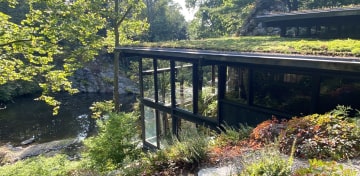

The Solution
We are the solution. Our residential, ornamental, and recreational landscapes can provide sufficient habitat to restore the bird population. We just need to add the essential ingredients and stop using pesticides. No petitions, no donations, no bureaucracy. We can simply stop being the problem by changing the way we garden.
Birds need 70% (approx 2/3) native plants in their range to maintain healthy population levels.* If even half of America’s 40 million acres of lawn was converted to native plants* and pesticide free maintenance, we could turn the bird losses into gains. This is the Two Thirds for the Birds goal. If all of our yards, parks, and campuses commit to Two Thirds, they will eventually connect and create life filled corridors of habitat.
* Tallamy et al.
“Restoring viable habitat … is the single most effective thing we can do….(it) will not only stop species loss but will reverse it.”
— Doug Tallamy

The Solution is in our hands, in our lands. Two Thirds for The Birds is a call to action and an access to tools: how to do it, who is doing it, and how well we are doing.
We celebrate commitments, and share knowledge and experience.
Every time we make even the smallest decision about caring for a piece of land, we have an opportunity to be the solution.
Fundamentals of Two Thirds
The two largest drivers of the bird decline are loss of habitat and use of pesticides.
There are three simple things you can do:
- plant two native plants for every three
- remove invasives
- stop using pesticides.
You can start any place, no matter how small or how filled with exotics. The important thing is that from this moment on, you think (and plant) Two Thirds so that in time it will be habitual for all landscapes to be habitats.
We are looking to landscape design professionals and environmental organizations to lead the way; to provide expertise, inspiration, and guidance; to ask every client, board member, and employee to make this commitment. To take it and fly with it.
Native Plants

Native plants provide the healthiest food and most perfect shelter for the species they evolved with and serve. Native plants have co-evolved with birds, and with the insects they feed on. On the other hand, exotic plants, which evolved with a different set of co-dependents and have no particular connections in their new ecosystems, have become highly favored in our landscapes because “nothing will eat them”. They are not doing anything to feed and house our birds.
Habitat-rich Landscapes

A Two Thirds habitat landscape is an entire, lively ecosystem. How will yours get that way? Plant the right plants in the right place, give them a modicum of loving care, and they will provide the all right stuff for the rest of the food web.
Our farms provide food for humans; the rest of our land, our landscapes, need to provide food for all other life on earth. When a native landscape is functioning and feeding happily, sharing the bounty with insects and birds is all part of the fascination and fun.
Pesticide-free Practices

Our landscapes have become sterile extensions of our homes: tidy, bug free, tightly controlled. This kind of “no surprises” landscaping is easy to design and maintain: it requires little knowledge and lots of fertilizers, pesticides, and motorized equipment.
Chemical free landscapes are beautiful and full of life. Instead of regular inputs of questionable products, all they need are the right practices: caring, observation, trust in nature.
They also need the right expectations. Changing perceptions of what our yards should look like is a big challenge for reintroducing habitat. Changing the way the entire landscape industry operates is a close second.
Health
“Restoring viable habitat … is the single most effective thing we can do….(it) will not only stop species loss but will reverse it.”
— Lancet Commission on Planetary Health, 2015 Report

There is more and more science to support the obvious: landscape chemicals are bad for us, our pets, and the planet. Time spent in healthy, chemical free landscapes is good for us. Watching butterflies and bees and trees and leaves has measurable positive physical and mental benefits. Creating a nature based landscape, a positive environmental action, compounds the effect.